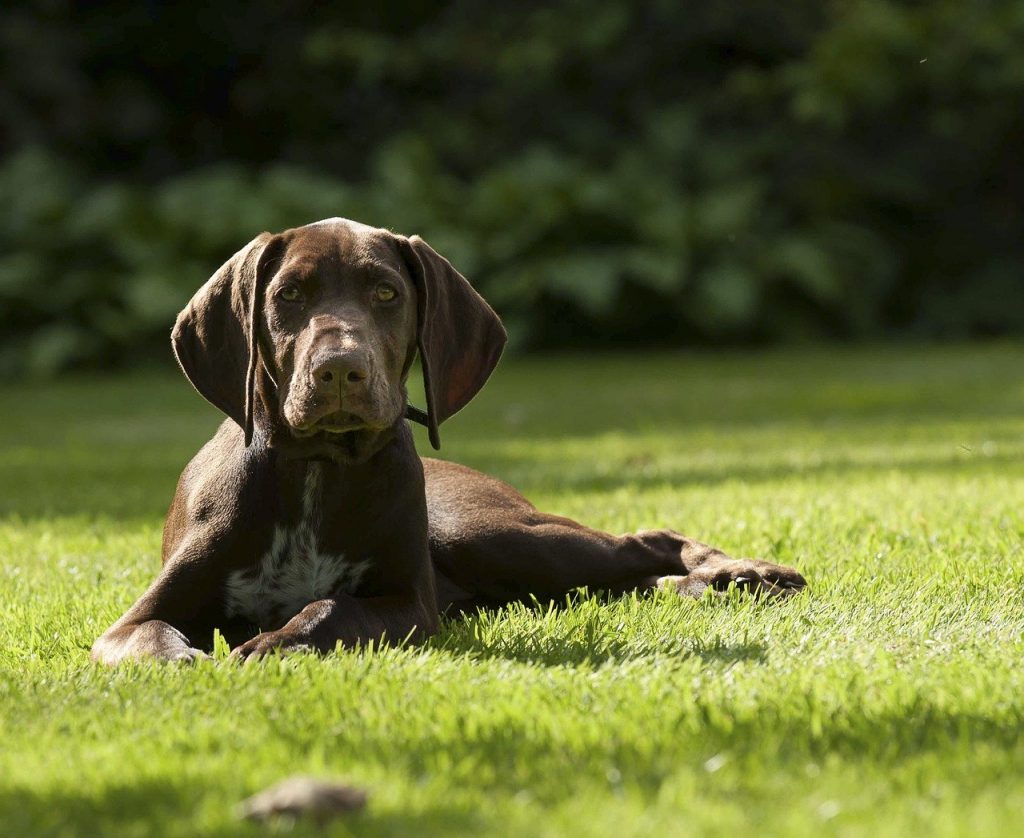Overview
Group: Sporting Group
AKC Breed Popularity Rank: No. 9 of 195
Height: Male – 23-25 inches; Female – 21-23 inches
Weight: Male – 55-70 lbs; Female – 45-60 lbs
Life Span: 10-12 years
Temperament: Friendly; Aristocratic; Smart; Eager to please
The German Shorthaired Pointer (GSP) is a very popular hunting and gun dog as evidenced by its No. 9 rank in AKC’s Breed Popularity list. However, as many dog lovers have discovered, the GSP is not only a “perfect pointer”; it is also an excellent family companion.
History
The German Shorthaired Pointer is the result of the efforts of German hunters as early as the 1700s to develop the perfect bird dog. But the one individual who succeeded is Prince Albrecht za Solms-Braunfels. Together with his fellow breeders, they developed a very versatile dog that is not only a pointer, but also has the tenacity of a retriever and the sharp nose of a night tracker.
The GSP not only pursues gamebirds; it can also track rabbits, raccoons, possums, and even deer. However, the breed not only excels in hunting. It is also a loyal and dedicated family dog that loves to play with children.
General Appearance
The GSP is a lean, well-balanced dog whose streamlined body evokes grace and speed. The breed comes in three coat types – short-haired, long-haired, and wire-haired – in liver, brown, and black colors with characteristic white or colored ticking patterns. It has a clean-cut head with broad, drop ears which are rounded at the tips and brown noses. It has a low carrying tail which tapers to a white tip.
One distinguishing characteristic of the GSP is its spoon-shaped, compact, and webbed feet. This makes the breed excellent swimmers, so that they can chase game fowl even in the water.
What makes the GSP an ideal family dog as well is its temperament. It is a very friendly, affectionate, eager-to-please, and intelligent dog, which makes it a perfect pet for families with children. It is not uncommon to see the GSP curling up to their owners and their kids during quiet times at home.
Nutrition
GSPs will thrive on high quality dog food, that is appropriate to the dog’s age and level of activity. Because of their high energy levels, puppies below 6 months of age can be fed more than twice daily. But once they become adults, it is sufficient to just give them morning and evening meals.
Dog experts, however, warn that the GSP is of high risk for bloat. To prevent this, the dog should not be fed immediately after any vigorous activity, such as running. The dog should also not be permitted to run or exercise at least one hour after eating and drinking. It is recommended that the dog be fed in the evenings when all physical activities are done.
Grooming
Thankfully, the GSP has a coat that is very easy to groom. You only need to brush it with a brush or grooming glove to remove dead hairs. Take note though that the GSP still sheds, especially in the spring and fall. If you and your dog live in warmer climes, expect your GSP to shed all year round.
The one problem that dog owners have with shedding season is that the loose hairs get embedded in furniture fabrics and carpets and are hard to remove. Aside from brushing, regular bathing with a gentle shampoo can help remedy this problem.
Because of its drop ears, make sure to check its ears regularly. You also need to trim your dog’s nails.
Exercise
Because of its boundless energy, the GSP needs a lot of exercise, such as running, swimming, and other dog sports. If they are not allowed to release their energy, the dog has a tendency to become hyperactive and destructive. The ideal exercise routine for the GSP is brisk, 30-minute walks or runs twice a day, preferably on a leash and harness or within a securely fenced area.
Training
For a very active dog, the GSP needs to undergo early training, and this includes puppy training with basic obedience and socialization. While the GSP is smart and easy to train, they can be quite challenging at the age range of six months to three years. The key to training a GSP well is through consistency.
Nevertheless, a GSP will become a happier dog if its owner has an active lifestyle that matches its exuberance.
Health
GSPs are prone to diseases that are common to medium or large-sized dog breeds. These diseases would include hip dysplasia, heart diseases, and progressive retinal atrophy.
As was mentioned earlier, the GSP is prone to bloat. Aside from making the necessary adjustments to its mealtimes, it is very important that owners know the symptoms of bloat so that they will know what to do in case it develops in their dogs.
Costs
The average cost of a GSP puppy is $700. But the price range increases to $1,400 to $5,500 if the puppy comes from a show quality line. Because it is important to maintain the dog’s good health, upkeep costs may go as high as $500 to $2,000 a year.
While the German Shorthaired Pointer is not a well-known breed, it is important to keep this dog in mind if you want a dog that can keep up with your active lifestyle. Another plus for owning a GSP is its affectionate and loving devotion to its family, including the children.
SOURCES:
1) German Shorthaired Pointer https://www.akc.org/dog-breeds/german-shorthaired-pointer/
2) Managing German Shorthaired Pointer Shedding https://canna-pet.com/managing-german-shorthaired-pointer-shedding/
3) German Shorthaired Pointer Puppies for Sale https://www.nextdaypets.com/German-Shorthaired-Pointer.htm


